Converting Signal
Strength Percentage to
dBm Values
Executive Summary
WildPacketsí 802.11 wireless LAN packet analyzers, AiroPeek and
AiroPeek NX, provide a measurement of RF signal strength represented by
a percentage value. The question sometimes arises as to why a percentage
metric is used, and how this relates to the actual RF energy that is present in
the environment. This paper discusses RF technology with sufficient detail
to provide a basis for understanding the issues related to signal strength
measurement.
November 2002
�
Contents
Measurement Units for RF Signal Strength.............................................. 1
The mW and dBm Units of Measure.......................................................... 1
The Receive Signal Strength Indicator (RSSI).......................................... 3
RSSI in the 802.11 Standard ...................................................................... 4
Granularity in RSSI Measurements ........................................................... 4
The Choice of a Suitable Energy Range for Measurement ..................... 4
The Low Energy End of the Measurement Range.................................... 5
Using a Percentage Signal Strength Metric.............................................. 5
The Impossibility of Measuring 0% Signal Strength................................ 5
Signal Strength and the Inverse Square Law ........................................... 5
Experimental Confirmation of Theoretical Assumptions........................ 6
Practical Conversion from Percentage to dBm........................................ 7
Conversion for Atheros.................................................................................. 7
Conversion for Symbol.................................................................................. 7
Conversion for Cisco ..................................................................................... 8
Conclusions................................................................................................. 9
Copyright © 2002 WildPackets, Inc. All Rights Reserved.
Page 1
�
Converting Signal Strength Percentage to dBm Values
AiroPeek and AiroPeek NX provide a measurement of RF signal strength represented by
a percentage value. The question sometimes arises as to why a percentage metric is used,
and how this relates to the actual RF energy that is present in the environment. This paper
discusses RF technology with sufficient detail to provide a basis for understanding the
issues related to signal strength measurement.
Measurement Units for RF Signal Strength
There are four units of measurement that are all used to represent RF signal strength.
These are: mW (milliwatts), dBm (“db”-milliwatts), RSSI (Receive Signal Strength
Indicator), and a percentage measurement. All of these measurements are related to each
other, some more closely than others. It is possible to convert from one unit to another,
albeit with varying degrees of accuracy, and not always in the extremes of the
measurement range.
The mW and dBm Units of Measure
The first two units to consider are the mW and the dBm (pronounced “dee-bee-em” or
spoken as “dee-bee milliwatts”). When energy is measured in milliwatts (mW), the mW
signal level is, simply, the amount of energy present. An electrical engineer or physicist
could explain “energy” in more detail, but it is sufficient to think about the fact that a
typical wireless access point or quality wireless client NIC has a rated output of 100 mW.
Because of the peculiarities of measurement, it turns out that the measuring RF energy in
mW units is not always convenient. This is due, in part, to the fact that signal strength
does not fade in a linear manner, but inversely as the square of the distance. This means
that if you are a particular distance from an access point and you measure the signal level,
and then move twice as far away, the signal will decrease by a factor of four. You move by
2x and the signal decreases by 1/4x; hence, the “inverse square law.” In any case, the fact
that exponential measurements are involved in signal strength measurement is one reason
why the use of a logarithmic scale of measurement was developed as an equivalent, but
alternative way of representing RF power.
The “dBm” (dB-milliwatt) is a logarithmic measurement of signal strength, and dBm
values can be exactly and directly converted to and from mW values. Just like miles and
kilometers can be converted directly, so can mW and dBm (of course, the mW-to-dBm
conversion is from a linear scale to a logarithmic scale, and miles-to-kilometers would be
linear-to-linear).
A mW measurement is first converted to a base-10 logarithm. It turns out that the
logarithm values are quite small; convention multiplies this value by 10 with the resulting
value called dBm. Here are some examples to help clarify this relationship:
100mw log 100 = 2 and 10^2=100 20dBm = 100mW
50mw log 50 = 1.698 and 10^1.698 = 50 15.9dBm = 50 mW
25mw log 25 = 1.397 and 10^1.397 = 25 13.9dBm = 25mW
13mw log 13 = 1.113 and 10^1.113 = 13 11.1dBm = 13mW
Converting Signal Strength Percentage to dBm Values
Page 2
�
The mW and dBm Units of Measure
You can prove these relationships with your scientific calculator. Notice that each time
the actual mW power level becomes half as great, the dBm measurement goes down by
(roughly) 3 dBm. As a general guideline, it is convenient to remember that a decrease of
3dBm yields roughly half the original value and, conversely, an increase of 3dBm yields
roughly twice the original value.
Of course, power is always a positive quantity. You can’t have “negative energy” (unless
you’re studying quantum mechanics and virtual particles!), so the mW measurement will
always be something greater than zero. You can, however, have very small values; much
less than 1. When representing a fraction less than 1 (but greater than zero), it can be
shown that the corresponding logarithmic value is negative. You can prove the following
relationships on your calculator if you desire:
1 mW log 1 = 0 and 10^0=1 0dBm = 1mW
.5 mW log .5 = -0.3010 and 10^-0.3010 = .5 -3.01dBm = .5mW
.25mW log .25 = -0.602 and 10^-0.602=.25 -6.02dBm = .25mW
.13 mW log .13 = -0.886 and 10^-0.886=.13 -8.86dBm = .13mW
Notice, again, that a decrease of roughly 3dBm yields a change of roughly half in the mW
value. It is worth noting, for the discussion that will be presented later in this document,
that if you continued building the table until you got down to .0000000002511 mW, you
would find that this was equal to –96dBm. It turns out that .0000000002511 mW is about
as tiny an RF signal that can be received by most standard 802.11 NICs. This is the
“receiver sensitivity” level. As you can see, it is much easier to say, and write, “-96dBm”
than to have to figure out where all the zeros are and whether you’re talking about “pico-
watts” or “fempto-watts” (it is “fempto,” by the way; that’s why we talk about dBm,
which is a much more useful way of measuring signal strength at very low levels).
We can now say, “An 802.11 NIC transmits power at roughly 20dBm and can receive
power all the way to –96dBm.” You should realize that while it is reasonable to talk about
20dBm as being 100mW, it is cumbersome to talk about –96dBm as being
.0000000002511 mW. You should realize that convenience and ease-of-understanding are
two fundamental reasons why the dBm metric is used for RF signal strength, rather than
mW.
The graph below shows the mathematical relationship between dBm measurements and
their corresponding mW values. The actual formula used for the conversion is:
dBm = log (mW) * 10
Converting Signal Strength Percentage to dBm Values
Page 3
�
The Receive Signal Strength Indicator (RSSI)
Relation Between dBm and mW
35
1
1
2
9
2
7
3
5
4
3
5
1
6
9
6
7
7
5
8
3
9
9
1
-
E
2
6
3
7
6
8
.
6
1
-
E
5
4
0
2
2
2
.
4
1
-
E
4
3
4
8
6
5
.
1
1
-
E
9
1
5
5
4
1
.
9
0
-
E
9
2
5
2
7
3
.
7
0
-
E
4
7
6
3
5
9
.
1
4
1
4
4
2
0
0
0
0
.
5
2
6
0
0
.
20
0
-20
-40
-60
-80
-100
m
B
d
Milliwatts (mW)
What you can see in the graph is that there is a relatively linear appearance to the slope as
it rises from –100 dBm to the point where the mW value is roughly 5. At that point, the
curve turns sharply to the right and flattens out. After the curve a relatively large change
in mW value is required to make a significant change in dBm. This is purely a
mathematical relationship, however. As will be shown, the fact that dBm measurements
don’t change much above 5 mW will be significant in how 802.11 NIC manufacturers
have chosen to present RF signal strength measurements.
The Receive Signal Strength Indicator (RSSI)
The IEEE 802.11 standard defines a mechanism by which RF energy is to be measured
by the circuitry on a wireless NIC. This numeric value is an integer with an allowable
range of 0-255 (a 1-byte value) called the Receive Signal Strength Indicator (RSSI). No
vendors have chosen to actually measure 256 different signal levels, and so each vendor’s
802.11 NIC will have a specific maximum RSSI value (“RSSI_Max”). For example,
Cisco chooses to measure 101 separate values for RF energy, and their RSSI_Max is 100.
Symbol uses an RSSI_Max value of 31. The Atheros chipset uses an RSSI_Max value of
60. Therefore, it can be seen that the RF energy level reported by a particular vendor’s
NIC will range between 0 and RSSI_Max. Notice that nothing has been said here about
measurement of RF energy in dBm or mW. RSSI is an arbitrary integer value, defined in
the 802.11 standard and intended for use, internally, by the microcode on the adapter and
by the device driver. For example, when an adapter wants to transmit a packet, it must be
able to detect whether or not the channel is clear (i.e., nobody else is transmitting). If the
RSSI value is below some very low value, then the chipset knows that the channel is
clear. This is the “Clear Channel Threshold” and some particular RSSI value is associated
with it. When an 802.11 client is associated to an access point and is roaming, there
comes a point when the signal level received from the access point drops to a somewhat
low value (because the client is moving away from the access point). This level is called
the “Roaming Threshold” and some intermediate (but low) RSSI value is associated with
it. Different vendors use different signal levels for the Clear Channel Threshold and the
Roaming Threshold and, moreover, the RSSI value that represents these thresholds
differs from vendor-to-vendor because different RSSI_Max values are implemented.
Converting Signal Strength Percentage to dBm Values
Page 4
�
RSSI in the 802.11 Standard
RSSI in the 802.11 Standard
Here is what the IEEE 802.11 standard says about the RSSI metric:
14.2.3.2 RXVECTOR RSSI
The receive signal strength indicator (RSSI) is an optional parameter that has a value of 0
through RSSI Max. This parameter is a measure by the PHY sublayer of the energy observed
at the antenna used to receive the current PPDU. RSSI shall be measured between the
beginning of the start frame delimiter (SFD) and the end of the PLCP header error check
(HEC). RSSI is intended to be used in a relative manner. Absolute accuracy of the RSSI
reading is not specified.
Notice that the parameter is specified as optional, although all 802.11 NIC manufacturers
appear to implement it. Of greatest significance are the last two sentences: “The RSSI is
intended to be used in a relative manner. Absolute accuracy of the RSSI reading is not
specified.”
There is no specified accuracy to the RSSI reading. That is, there is nothing in the 802.11
standard that stipulates a relationship between RSSI value and any particular energy level
as would be measured in mW or dBm. Individual vendors have chosen to provide their
own levels of accuracy, granularity, and range for the actual power (measured as mW or
dBm) and their range of RSSI values (from 0 to RSSI_Max).
Granularity in RSSI Measurements
The concept of “granularity” is important to consider here, too. Since the RSSI value is
an integer it must increase or decrease in integer steps. For example, Symbol provides 32
separate “steps,” Cisco provides 101 (i.e., from 0 to RSSI_Max for any given
manufacturer). Whatever range of actual energy is being measured, it must be divided
into the number of integer steps provided by the RSSI range. Therefore, if RSSI changes
by 1, it means that the power level changed by some proportion in the measured power
range. There are, therefore, two important considerations in understanding RSSI. First, it
is necessary to consider what range of energy (the mW or dBm range) that’s actually
being measured. Secondly, it must be recognized that all possible energy levels (mW or
dBm values) cannot be represented by the integer set of RSSI values.
The Choice of a Suitable Energy Range for Measurement
As was seen in the dBm-to-mW graph above, there is not much change in dBm values
above roughly 5 mW. Wireless NIC manufacturers do not measure signal strength in that
range. RF energy is almost always measured using dBm values, because the measured
range would otherwise have mW values with too many zeros to the right of the decimal
point to make for ease of understanding. The graph also shows that the slope of change
for dBm below 5mW is very roughly linear, but not exactly. The logarithmic nature of the
dBm measurement, coupled with the fact that the RSSI range used for measurement
contains dBm “gaps” (due to the integer nature of the RSSI value), has led many vendors
to map RSSI to dBm using a table. These mapping tables allow for adjustments to
accommodate the logarithmic nature of the curve. The range of energy that is typically
measured begins at or below –10dBm (and, compared to the +20dBm of potential output
power at a 100mW access point, that’s a relatively weak signal). In addition to the fact
that the graph “flattens out” at higher power levels, the –10dBm upper limit on the energy
level measurement range is also consistent with the purpose for RSSI measurements in
the first place. Remember that RSSI is intended for use in Clear Channel assessment and
determination of the Roaming Threshold. It makes sense that the circuitry is designed to
provide reasonable accuracy in this range.
Converting Signal Strength Percentage to dBm Values
Page 5
�
The Low Energy End of the Measurement Range
The Low Energy End of the Measurement Range
The receiver circuit in an 802.11 NIC must have a minimum level of available RF energy
(above the level of the background noise) in order to extract a bit-stream. This minimum
level is called the “Receive Sensitivity” and is a NIC spec measured in dBm. For
example, a NIC manufacturer may indicate that their particular card has a Receive
Sensitivity of –96dBm at 1Mb/sec. If the actual RF energy present at that card were less
than –96dBm then the card would no longer be able to differentiate between signal and
noise. The dBm value for a NICs Receive Sensitivity is very close to the dBm value
associated with an RSSI value of 0. Hence, the Receive Sensitivity of the adapter
determines the lower end of the necessary measurement range for signal strength. It
should be noted that, typically, if RSSI=0 the dBm signal measurement is below the
Receive Sensitivity level.
Using a Percentage Signal Strength Metric
To circumvent the complexities (and potential inaccuracies) of using RSSI as a basis for
reporting dBm signal strength, it is common to see signal strength represented as a
percentage. The percentage represents the RSSI for a particular packet divided by the
RSSI_Max value (multiplied by 100 to derive a percentage). Hence, a 50% signal
strength with a Symbol card would convert to an RSSI of 16 (because their RSSI_Max =
31). Atheros, with RSSI_Max=60, would have RSSI=30 at 50% signal strength. Cisco
ends up making life easy with an RSSI_Max =100, so 50% is RSSI=50.
It can be seen that use of a percentage for signal strength provides a reasonable metric for
use in network analysis and site survey work. If signal strength is 100%, that’s great!
When signal strength falls to roughly 20%, you’re going to reach the Roaming Threshold.
Ultimately, when signal strength is down somewhere below 10% (and probably closer to
1%), the channel is going to be assumed to be clear. This conceptualization obviates the
need to consider dBm, the RSSI_Max, or the “knee” in the logarithmic curve of mW to
dBm conversion. It allows a reasonable comparison between environments even though
different vendor’s NICs were used to make the measurements. Ultimately, the generalized
nature of a percentage measurement allows the integer nature of the RSSI to be
overlooked.
The Impossibility of Measuring 0% Signal Strength
In the preceding paragraph, you may have noticed the note in parentheses stating that the
clear channel threshold was “probably closer to 1%.” There is a very profound reason
why this was not “0%.” If signal strength falls to 0%, it can be assumed that RSSI=0 and,
hence, the signal strength is at, or below, the Receive Sensitivity of the NIC. A NIC can’t
report that a particular packet has “0% signal strength,” because if there were no available
signal, there would be no packet to measure!
It is impossible for any tool using a standard wireless NIC to measure signal strength
below the NIC’s Receive Sensitivity threshold.
Signal Strength and the Inverse Square Law
Earlier, it was stated that the “inverse square law” defined how an RF signal would be
reduced in power. A physicist might explain that there are other factors that come into
play with signal attenuation, but the inverse square law has the most dramatic impact. In
fact, when measurements are taken at a distance greater than approximately one
wavelength away from an electromagnetic radiator, the other influences to the energy
level of the radiated wave become insignificant and can be ignored. Imagine that a
100mW access point actually had 100mW of measured power 1-inch away from the
Converting Signal Strength Percentage to dBm Values
Page 6
�
Experimental Confirmation of Theoretical Assumptions
antenna. Of course, this is a thought experiment only. Antenna loss or gain, and the actual
energy of the radiated signal, would influence the real-world measured power and
probably not be exactly 100mW. The thought experiment is, nonetheless, interesting.
Immediately we’re faced with an impossible situation. If the measured power were
100mW at a distance of 1-inch, then the measured power would be 400mW at a distance
of ¾-inch (by the inverse-square law). At ¼-inch, the power would have to jump up to
1600mW. Obviously, this is not reality. In fact, theoretical measurements of RF signals
are a challenge for students in college physics classes and they involve some complicated
formulae. You see, when a transmitter is rated at 100mW, there is an implication that a
100mW signal is present at the last point in the transmitter circuit before the signal enters
the antenna! The antenna will introduce some loss or gain, and what comes out will be
assumed to be at the power level derived from adjusting the power at the antenna by that
gain or loss.
Continuing the thought experiment, however, and recognizing that real-world
measurement would probably be smaller than those derived in the thought experiment,
adds to an understanding of why RSSI values are associated with dBm signal strengths at
levels below -10dBm. If the measured power at 1-inch from an antenna were 100mW,
then we could imagine the following measurements, based on the inverse-square law:
1" = 100mW = 20dBm
2" = 25mW = 13.9dBm
4" = 6.25mW = 7.9dBm
8" = 1.56mW = 1.9dBm
16" = 0.39mW = -4.08dBm
32" = .097mW = -10.1dBm
64" = .024mW = -16.1dBm (5.3 feet away)
128" = .006mW = -22.2dBm (10.6 feet away)
256" = .0015mW = -28.2dBm (21.3 feet away)
What you see from the table is that somewhere between roughly 5 feet and 20 feet away
from a 100mW radiator, the signal strength falls to below -20dBm. Consequently,
measurements represented by RSSI values that refer to energy levels below -10dBm (or
lower) are reasonable and practical.
Experimental Confirmation of Theoretical Assumptions
Engineers at WildPackets performed some limited experiments to see how closely these
theoretical concepts matched with real-world measurements. An access point rated at
100mW was measured using AiroPeek NX. It was found that within 5 feet of the access
point, the indicated signal strength remained at 100%, indicating that the signal was as
strong or stronger than the high-end of the dBm range of measurement used by the NIC.
Between 5 and 10 feet away from the access point the signal strength occasionally fell to
as low as 80%, but essentially hovered at 100%, with only occasional drops to 80%.
Measurements were made on the far side of a drywall-on-wooden-stud wall. It was found
that there, too, signal strength remained at 100% within 5-feet of the access point. The
conclusion drawn from these experiments was that use of AiroPeek for measuring signal
strength was reasonable beyond 10 feet from the access point. However, the variations in
measured signal level (the “hovering” of the signal strength with a 20% variation) meant
that site survey measurements would be generalized, at best. General measurements
would be suitable for many practical site survey situations, since a key determination in a
site survey involves identifying places where the signal strength is unacceptably low, as
opposed to creating an accurate dBm signal strength map of a particular environment. As
long as the measured signal strength remains above 30%, there should be sufficient signal
for normal 802.11 operations. In practice, one could determine the signal strength
Converting Signal Strength Percentage to dBm Values
Page 7
�


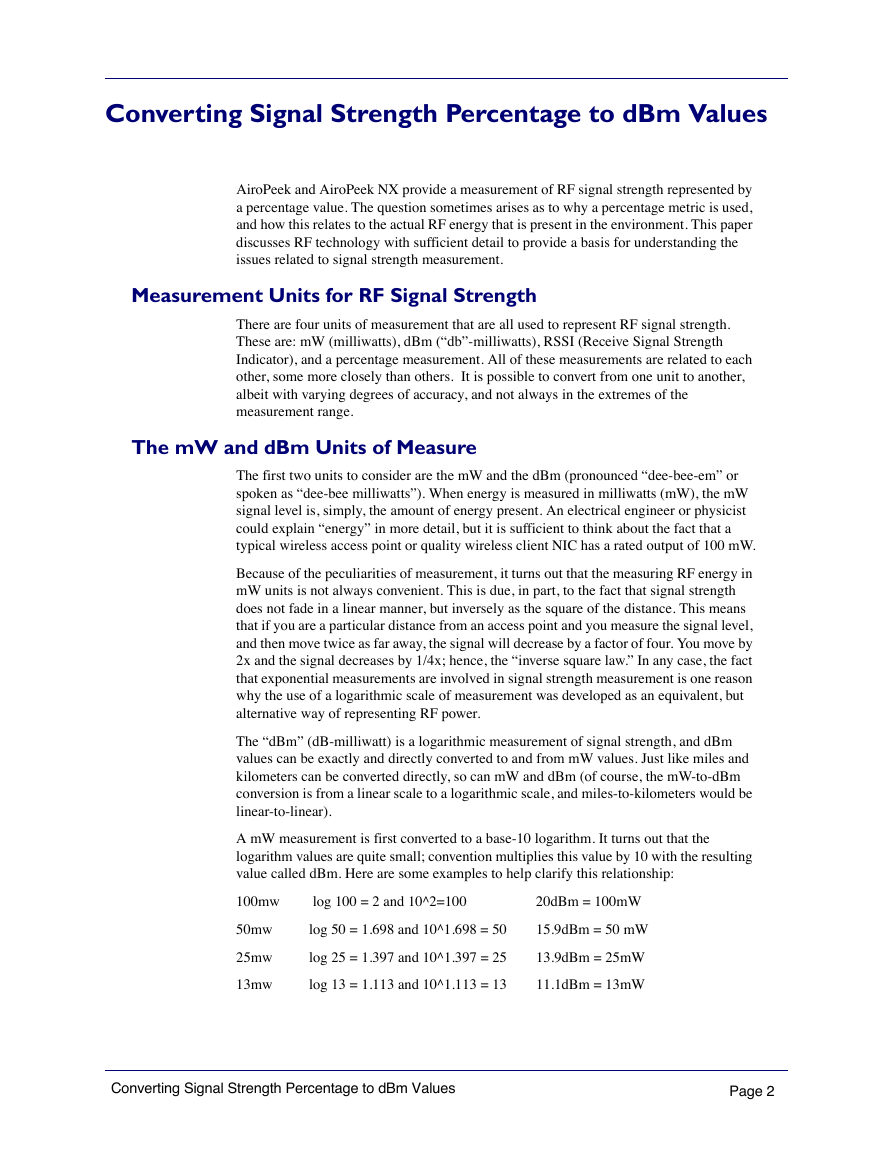
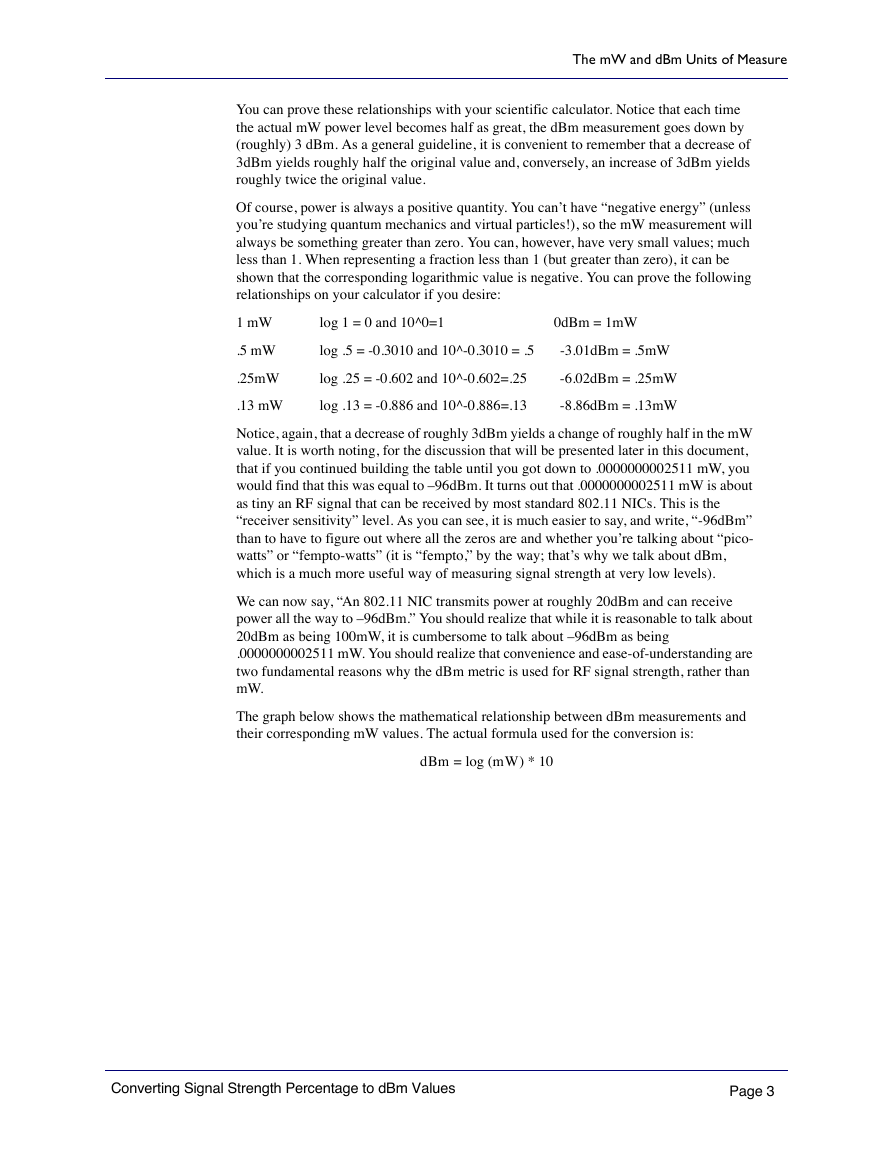

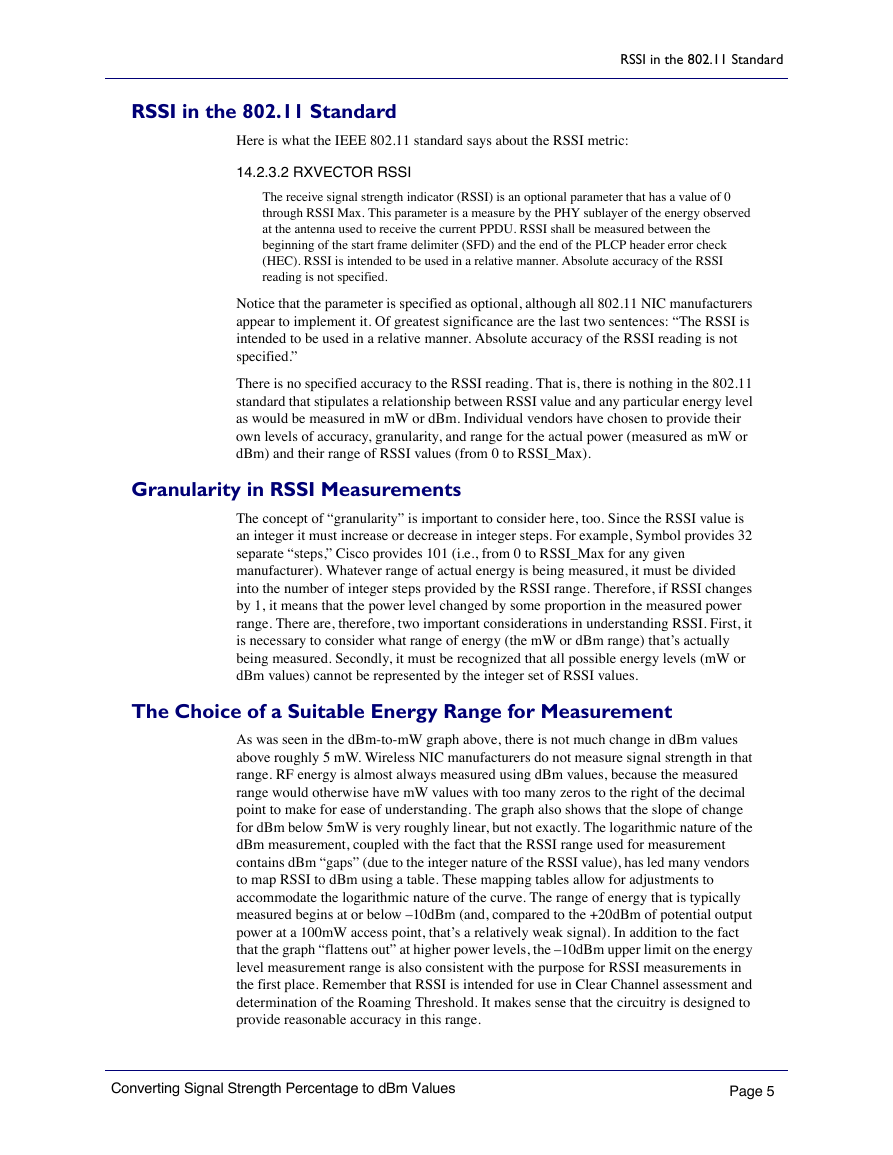
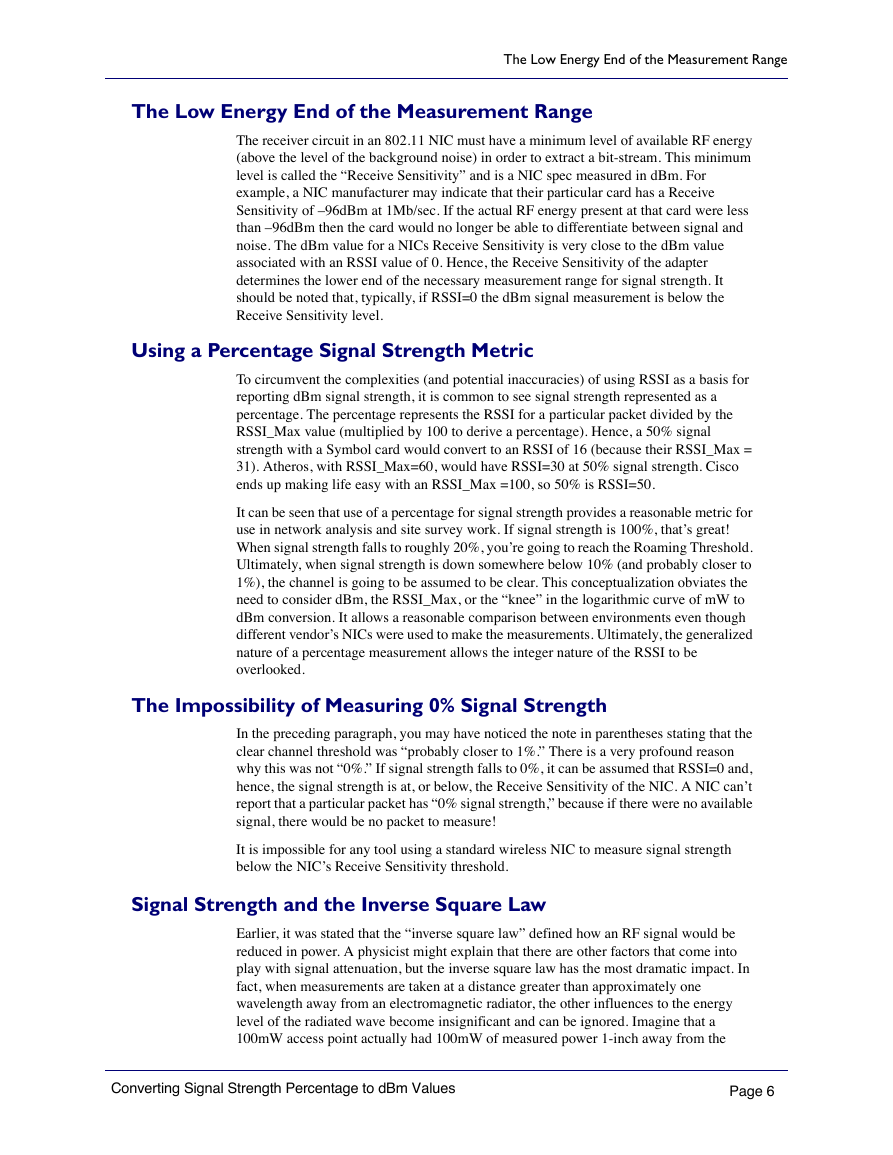
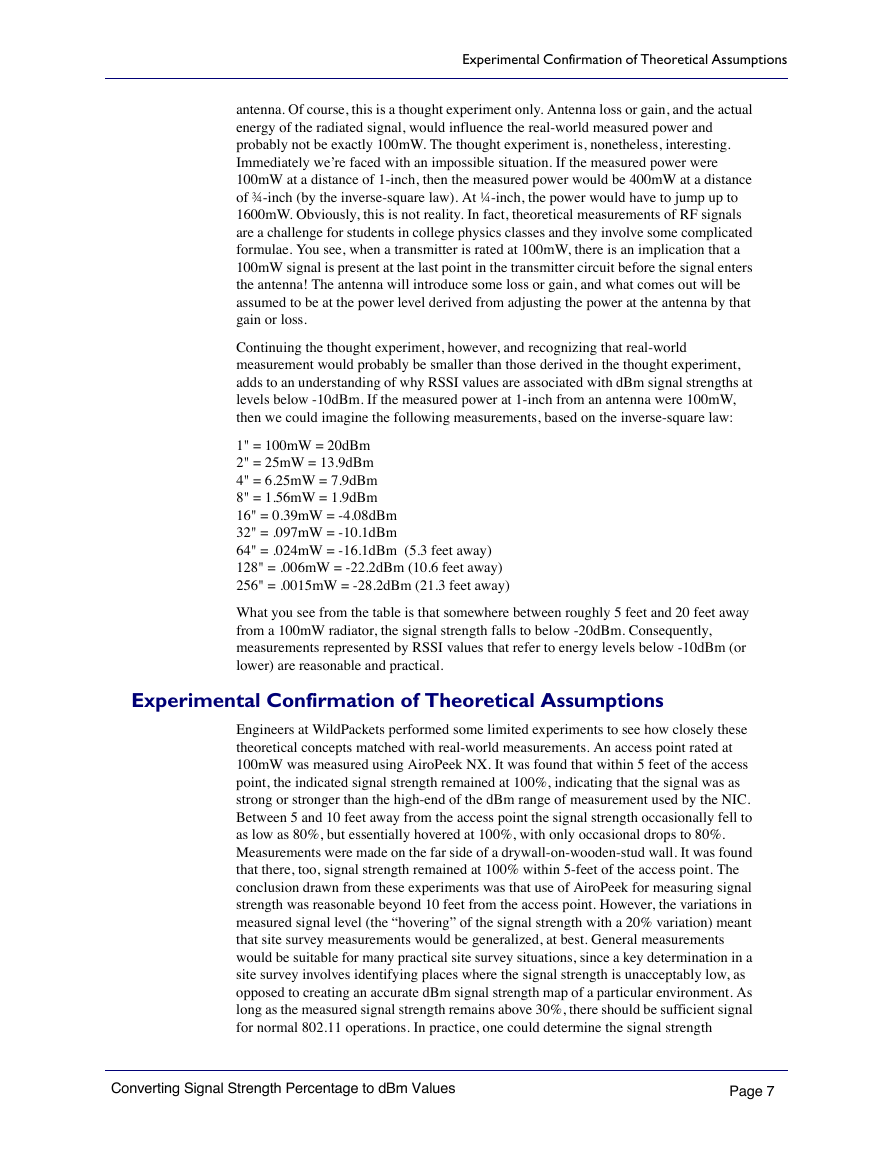








 2023年江西萍乡中考道德与法治真题及答案.doc
2023年江西萍乡中考道德与法治真题及答案.doc 2012年重庆南川中考生物真题及答案.doc
2012年重庆南川中考生物真题及答案.doc 2013年江西师范大学地理学综合及文艺理论基础考研真题.doc
2013年江西师范大学地理学综合及文艺理论基础考研真题.doc 2020年四川甘孜小升初语文真题及答案I卷.doc
2020年四川甘孜小升初语文真题及答案I卷.doc 2020年注册岩土工程师专业基础考试真题及答案.doc
2020年注册岩土工程师专业基础考试真题及答案.doc 2023-2024学年福建省厦门市九年级上学期数学月考试题及答案.doc
2023-2024学年福建省厦门市九年级上学期数学月考试题及答案.doc 2021-2022学年辽宁省沈阳市大东区九年级上学期语文期末试题及答案.doc
2021-2022学年辽宁省沈阳市大东区九年级上学期语文期末试题及答案.doc 2022-2023学年北京东城区初三第一学期物理期末试卷及答案.doc
2022-2023学年北京东城区初三第一学期物理期末试卷及答案.doc 2018上半年江西教师资格初中地理学科知识与教学能力真题及答案.doc
2018上半年江西教师资格初中地理学科知识与教学能力真题及答案.doc 2012年河北国家公务员申论考试真题及答案-省级.doc
2012年河北国家公务员申论考试真题及答案-省级.doc 2020-2021学年江苏省扬州市江都区邵樊片九年级上学期数学第一次质量检测试题及答案.doc
2020-2021学年江苏省扬州市江都区邵樊片九年级上学期数学第一次质量检测试题及答案.doc 2022下半年黑龙江教师资格证中学综合素质真题及答案.doc
2022下半年黑龙江教师资格证中学综合素质真题及答案.doc